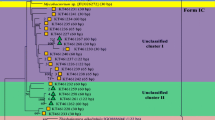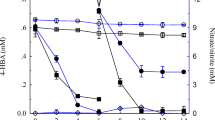Abstract
Humic substances (HS) in soil are widely distributed in cold environments and account for a significant fraction of soil’s organic carbon. Bacterial strains (n = 281) were isolated at 15 °C using medium containing humic acids (HA), a principal component of HS, from a variety of polar soil samples: 217 from the Antarctic and 64 from the Arctic. We identified 73 potential HA-degrading bacteria based on 16S rRNA sequence similarity, and these sequences were affiliated with phyla Proteobacteria (73.9%), Actinobacteria (20.5%), and Bacteroidetes (5.5%). HA-degrading strains were further classified into the genera Pseudomonas (51 strains), Rhodococcus (10 strains), or others (12 strains). Most strains degraded HA between 10 and 25 °C, but not above 30 °C, indicating cold-adapted degradation. Thirty unique laccase-like multicopper oxidase (LMCO) gene fragments were PCR-amplified from 71% of the 73 HA-degrading bacterial strains, all of which included conserved copper-binding regions (CBR) I and II, both essential for laccase activity. Bacterial LMCO sequences differed from known fungal laccases; for example, a cysteine residue between CBR I and CBR II in fungal laccases was not detected in bacterial LMCOs. This suggests a bacterial biomarker role for LMCO to predict changes in HS-degradation rates in tundra regions as global climate changes. Computer-aided molecular modeling showed these LMCOs contain a highly-conserved copper-dependent active site formed by three histidine residues between CBR I and CBR II. Phylogenetic- and modeling-based methods confirmed the wide occurrence of LMCO genes in HA-degrading polar soil bacteria and linked their putative gene functions with initial HS-degradation processes.



Similar content being viewed by others
References
Abakumov E, Alekseev I (2018) Stability of soil organic matter in cryosols of the maritime Antarctic: insights from 13c nmr and electron spin resonance spectroscopy. Solid Earth 9:1329–1339. https://doi.org/10.5194/se-9-1329-2018
Ausec L, van Elsas JD, Mandic-Mulec I (2011) Two- and three-domain bacterial laccase-like genes are present in drained peat soils. Soil Biol Biochem 43:975–983. https://doi.org/10.1016/j.soilbio.2011.01.013
Baldrian P (2006) Fungal laccases - occurrence and properties. FEMS Microbiol Rev 30:215–242. https://doi.org/10.1111/j.1574-4976.2005.00010.x
Bej AK, Saul D, Aislabie J (2000) Cold-tolerant alkane-degrading rhodococcus species from Antarctica. Polar Biol 23:100–105. https://doi.org/10.1007/s003000050014
Claus H (2003) Laccases and their occurrence in prokaryotes. Arch Microbiol 179:145–150. https://doi.org/10.1007/s00203-002-0510-7
Claus H (2003) Laccases and their occurrence in prokaryotes. Arch Microbiol 179:145–150. https://doi.org/10.1007/s00203-002-0510-7
Dick DP, Burba P, Herzog H (1999) Influence of extractant and soil type on molecular characteristics of humic substances from two Brazilian soils. J Braz Chem Soc 10:140–145. https://doi.org/10.1590/S0103-50531999000200012
Esham EC, Ye W, Moran MA (2000) Identification and characterization of humic substances-degrading bacterial isolates from an estuarine environment. FEMS Microbiol Ecol 34:103–111. https://doi.org/10.1111/j.1574-6941.2000.tb00759.x
Fakoussa RM, Frost PJ (1999) In vivo-decolorization of coal-derived humic acids by laccase-excreting fungus Trametes versicolor. Appl Microbiol Biotechnol 52:60–65. https://doi.org/10.1007/s002530051487
Freedman Z, Zak DR (2014) Atmospheric n deposition increases bacterial laccase-like multicopper oxidases: Implications for organic matter decay. Appl Environ Microbiol 80:4460–4468. https://doi.org/10.1128/AEM.01224-14
Freedman Z, Zak DR (2014) Atmospheric n deposition increases bacterial laccase-like multicopper oxidases: Implications for organic matter decay. Appl Environ Microbiol 80:4460–4468. https://doi.org/10.1128/AEM.01224-14
Gramss G, Ziegenhagen D, Sorge S (1999) Degradation of soil humic extract by wood- and soil-associated fungi, bacteria, and commercial enzymes. Microb Ecol 37:140–151. https://doi.org/10.1007/s002489900138
Granja-Travez RS, Bugg TDH (2018) Characterization of multicopper oxidase copa from Pseudomonas putida kt2440 and Pseudomonas fluorescens pf-5: involvement in bacterial lignin oxidation. Arch Biochem Biophys 660:97–107. https://doi.org/10.1016/j.abb.2018.10.012
Granja-Travez RS, Wilkinson RC, Persinoti GF, Squina FM, Fulop V, Bugg TDH (2018) Structural and functional characterisation of multi-copper oxidase cueo from lignin-degrading bacterium Ochrobactrum sp. reveal its activity towards lignin model compounds and lignosulfonate. FEBS J 285:1684–1700. https://doi.org/10.1111/febs.14437
Hoegger PJ, Kilaru S, James TY, Thacker JR, Kues U (2006) Phylogenetic comparison and classification of laccase and related multicopper oxidase protein sequences. FEBS J 273:2308–2326. https://doi.org/10.1111/j.1742-4658.2006.05247.x
Jurelevicius D, Alvarez VM, Peixoto R, Rosado AS, Seldin L (2012) Bacterial polycyclic aromatic hydrocarbon ring-hydroxylating dioxygenases (PAH-RHD) encoding genes in different soils from King George Bay, Antarctic Peninsula. Appl Soil Ecol 55:1–9. https://doi.org/10.1016/j.apsoil.2011.12.008
Kellner H, Luis P, Zimdars B, Kiesel B, Buscot F (2008) Diversity of bacterial laccase-like multicopper oxidase genes in forest and grassland cambisol soil samples. Soil Biol Biochem 40:638–648. https://doi.org/10.1016/j.soilbio.2007.09.013
Kim D, Park HJ, Nam S, Kim SC, Lee H (2019) Humic substances degradation by a microbial consortium enriched from subarctic tundra soil. Korean J Microbiol 55:367–376. https://doi.org/10.7845/kjm.2019.9141
Kumar S, Stecher G, Li M, Knyaz C, Tamura K (2018) MEGA X: molecular evolutionary genetics analysis across computing platforms. Mol Biol Evol 35:1547–1549
Lehmann J, Kleber M (2015) The contentious nature of soil organic matter. Nature 528:60–68. https://doi.org/10.1038/nature16069
Lipczynska-Kochany E (2018) Humic substances, their microbial interactions and effects on biological transformations of organic pollutants in water and soil: a review. Chemosphere 202:420–437. https://doi.org/10.1016/j.chemosphere.2018.03.104
Ma Y, Wang L, Shao Z (2006) Pseudomonas, the dominant polycyclic aromatic hydrocarbon-degrading bacteria isolated from antarctic soils and the role of large plasmids in horizontal gene transfer. Environ Microbiol 8:455–465. https://doi.org/10.1111/j.1462-2920.2005.00911.x
Mohammadian M, Fathi-Roudsari M, Mollania N, Badoei-Dalfard A, Khajeh K (2010) Enhanced expression of a recombinant bacterial laccase at low temperature and microaerobic conditions: Purification and biochemical characterization. J Ind Microbiol Biotechnol 37:863–869. https://doi.org/10.1007/s10295-010-0734-5
Necochea R, Valderrama B, Diaz-Sandoval S, Folch-Mallol JL, Vazquez-Duhalt R, Iturriaga G (2005) Phylogenetic and biochemical characterisation of a recombinant laccase from Trametes versicolor. FEMS Microbiol Lett 244:235–241. https://doi.org/10.1016/j.femsle.2005.01.054
Park HJ, Kim D (2015) Isolation and characterization of humic substances-degrading bacteria from the subarctic Alaska grasslands. J Basic Microbiol 55:54–61. https://doi.org/10.1002/jobm.201300087
Park HJ, Chae N, Sul WJ, Lee BY, Lee YK, Kim D (2015) Temporal changes in soil bacterial diversity and humic substances degradation in subarctic tundra soil. Microb Ecol 69:668–675. https://doi.org/10.1007/s00248-014-0499-x
Piontek K, Antorini M, Choinowski T (2002) Crystal structure of a laccase from the fungus Trametes versicolor at 1.90 Å resolution containing a full complement of coppers. J Biol Chem 277:37663–37669. https://doi.org/10.1074/jbc.M204571200
Quintanar L, Stoj C, Wang TP, Kosman DJ, Solomon EI (2005) Role of aspartate 94 in the decay of the peroxide intermediate in the multicopper oxidase Fet3p. Biochemistry 44:6081–6091. https://doi.org/10.1021/bi047379c
Stanier RY, Palleroni NJ, Doudoroff M (1966) The aerobic pseudomonad: a taxonomic study. J Gen Microbiol 43:157–271
Tikhonov VV, Yakushev AV, Zavgorodnyaya YA, Byzov BA, Demin VV (2010) Effects of humic acids on the growth of bacteria. Eurasian Soil Sci 43:305–313. https://doi.org/10.1134/S1064229310030087
Tribelli PM, Lopez NI (2018) Reporting key features in cold-adapted bacteria. Life (Basel) 8(1):8. https://doi.org/10.3390/life8010008
Van Trump JI, Sun Y, Coates JD (2006) Microbial interactions with humic substances. Adv Appl Microbiol 60:55–96. https://doi.org/10.1016/S0065-2164(06)60003-8
Yoon SH, Ha SM, Lim J, Kwon S, Chun J (2017) A large-scale evaluation of algorithms to calculate average nucleotide identity. Ant van Leeuwenhoek 110:1281–1286
Funding
This work was supported by Korea Polar Research Institute (grant PE20170).
Author information
Authors and Affiliations
Contributions
Ha Ju Park: investigation and writing of original draft; Yung Mi Lee: data curation and writing of original draft; Hackwon Do: investigation and writing of original draft; Jun Hyuck Lee: data curation and editing of original draft; Eungbin Kim: data curation and editing of original draft; Hyoungseok Lee: resources, data curation, and editing of original draft; Dockyu Kim: resources, conceptualization, data curation, and writing and editing of original draft.
Corresponding author
Ethics declarations
Conflict of interest
The authors declare that they have no conflict of interest.
Additional information
Publisher’s note
Springer Nature remains neutral with regard to jurisdictional claims in published maps and institutional affiliations.
Supplementary information
Below is the link to the electronic supplementary material.
Rights and permissions
About this article
Cite this article
Park, H.J., Lee, Y.M., Do, H. et al. Involvement of laccase-like enzymes in humic substance degradation by diverse polar soil bacteria. Folia Microbiol 66, 331–340 (2021). https://doi.org/10.1007/s12223-020-00847-9
Received:
Accepted:
Published:
Issue Date:
DOI: https://doi.org/10.1007/s12223-020-00847-9




